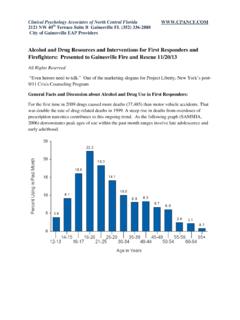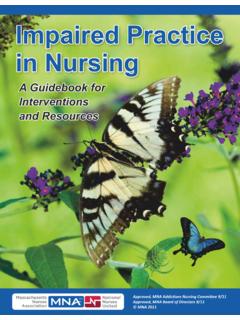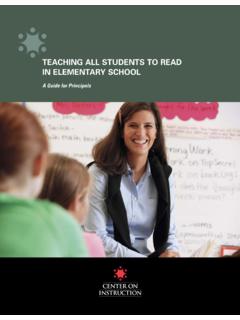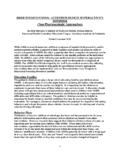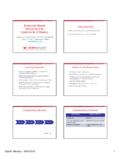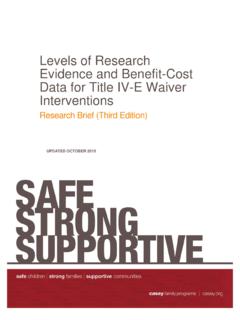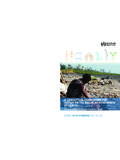Transcription of for Gender-based Violence Interventions in Humanitarian ...
1 Guidelinesfor Gender-based Violence Interventionsin Humanitarian SettingsFocusing on Prevention of and Response to Sexual Violence in EmergenciesIIAASSCCI nter-Agency Standing Committee Please note that all of the photos are of people in conflict situations, but that they are not specifically victims/survivors of Gender-based credits:Top row,left to right:IRIN; Women s Commission for Refugee Women andChildren; IOM 2003 - MMD0002 (Photo: Iurie Foca)Bottom row:WFP/Vanessa Vick; IOM 2003 MRU0030 (Photo: Cemil Alyanak) (top); IOM2002 MAF0102 (Photo: Jeff Labovitz) (bottom)Contact:The IASC Taskforce on Gender in Humanitarian :mail - Guidelinesfor Gender-based Violence Interventionsin Humanitarian SettingsFocusing on Prevention of and Response to Sexual Violence in EmergenciesSeptember 2005 iThe Inter-Agency Standing Committee Task Force on Gender and Humanitarian Assistance wishes to thankall the people who have collaborated on the development of these Guidelines.
2 They have given generouslyof their time and their version of theGuidelines for Gender-based Violence Interventions in Humanitarian Emergencies: Focusing onPrevention and Response to Sexual Violence will be field-tested in 2005-2006 and a final version of these Guidelineswill be prepared and endorsed by the IASC by the end of STANDING COMMITTEE Food and Agriculture Organisation (FAO)Office for the Coordination of Humanitarian Affairs (OCHA)United Nations Children s Fund (UNICEF)United Nations Development Programme (UNDP)United Nations Population Fund (UNFPA)United Nations High Commissioner for Refugees (UNHCR)World Food Programme (WFP)World Health Organisation (WHO)
3 Standing InviteesInterActionInternational Committee of the Red Cross (ICRC)International Council of Voluntary Agencies (ICVA)International Federation of the Red Cross and Red Crescent Societies (IFRC)International Organisation for Migration (IOM)Office of the High Commissioner for Human Rights (OHCHR)Representative of the Secretary-General on Human Rights of IDPsSteering Committee for Humanitarian Response (SCHR)World BankSignificant contributions to the development of these guidelines were made by UNIFEM and the followingpartners: the members of the Reproductive Health Response in Conflict Consortium; M decins sansFronti res; Oxfam; International Medical Corps; Christian Children s Fund.
4 The following academic institu-tions made substantial contributions:The International Centre for Reproductive Health of the GhentUniversity and The University of Inter-Agency Standing Committee (IASC) was established in 1992 in response to General AssemblyResolution 46/182 which called for strengthened coordination of Humanitarian assistance. The resolution setup the IASC as the primary mechanism for facilitating interagency decision-making in response to complexemergencies and natural disasters. The IASC is formed by the representatives of a broad range of UN andnon-UN Humanitarian partners.
5 For further information on the IASC, please access the IASC Standing Committee (2005)Guidelines for Gender-based Violence Interventions in Humanitarian Settings:Focusing on Prevention of and Response to Sexual Violence in Emergencies (Field Test Version)Geneva: Inter-Agency Standing CommitteeAcknowledgments ii iiiThe Inter-Agency Standing Committee has issued these Guidelines for Gender-based Violence Interventionsin Humanitarian Emergencies: Focusing on Prevention and Response to Sexual Violence to meet the needfor a coherent and participatory approach to prevent and respond to Gender-based Violence .
6 This is a tool tofor field actors to establish a multisectoral coordinated approach to Gender-based Violence programming inemergency Violence in armed conflict is a crime against humanity and is being used as a method of war to bru-talise and instil fear in the civilian population, especially women and girls. The Humanitarian community mustcome together and act together to put into place systems to prevent Violence from occurring and when itdoes, to respond to the needs of survivors/victims. The Guidelines provide practical advice on how toensure that Humanitarian protection and assistance programmes for displaced populations are safe and donot directly or indirectly increase women s and girls risk to sexual Violence .
7 The Guidelines also detail whatresponse services should be in place to meet the need of survivors/victims of sexual call upon all those who are involved in the provision of protection and Humanitarian assistance to usethese Guidelines and work together to prevent and respond to Gender-based Violence . We need a collectiveeffort to put an end to the brutality of sexual Violence and respond compassionately and more effectively tothose EgelandEmergency Relief Coordinator and Under-Secretary-General for Humanitarian AffairsForeword iv vAcknowledgementsiPrefaceiiiChapter 1.
8 Introduction1 Gender-based Violence Interventions in Emergencies1 Purpose of the Guidelines2 Target Audience2 How to Use These Guidelines2 Nature and Extent of GBV in Humanitarian Emergencies3 Chapter 2. Terms and Definitions7 Chapter 3. Gender-based Violence Interventions in Humanitarian settings9 Chapter 4. Action Sheets for Minimum Prevention and Response151. and Monitoring243. Protection294. Human Resources385. Water and Security and Nutrition497. Shelter and Site Planning and Non-Food Items538. Health and Community ,Education, Communication75 Annex 182 Action to address Gender-based Violence in emergencies:IASC Statement of CommitmentAnnex 284 SAMPLE Monitoring Form,Implementation of Minimum Prevention and ResponseAnnex 385 Sample Incident Report FormAnnex 487 AcronymsTable of Contents vi Page 1 Gender-based Violence (GBV), and in particularsexual Violence , is a serious, life-threatening protec-tion issue primarily affecting women and children.
9 Itis well documented that GBV is a widespread inter-national public health and human rights issue, andthat adequate, appropriate, and comprehensive pre-vention and response are inadequate in most coun-tries Violence is especiallyproblematic in the context of complex emergenciesand natural disasters, where civilian women andchildren are often targeted for abuse, and are themost vulnerable to exploitation, Violence , and abusesimply because of their gender, age, and status insociety. (See below, Nature and Extent of GBV inHumanitarian Emergencies, p. 3.)
10 Gender-based Violence is a violation of universalhuman rights protected by international humanrights conventions, including the right to security ofperson; the right to the highest attainable standardof physical and mental health; the right to freedomfrom torture or cruel, inhuman, or degrading treat-ment; and the right to Humanitarian actors musttake action, from the earlieststages of an emergency, to prevent sexual Violence and provide appropriate assistance to ViolenceInterventions in EmergenciesDuring a crisis,such as armed conflict or natural dis-aster, institutions and systems for physical and socialprotection may be weakened or destroyed.










